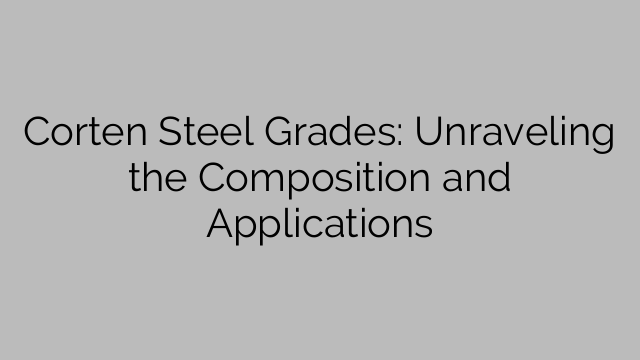The name “Corten” originates from its two main properties: corrosion resistance and tensile strength. Created by United States Steel Corporation in the early 20th century, it was primarily designed for use in railroad coal wagons. Over time, this steel grade has proven its exceptional resistance to corrosion, making it a preferred option for outdoor structures in harsh environments.
The composition of Corten steel grades is primarily composed of iron, which acts as the base metal. The key differentiator is the inclusion of specific alloying elements, such as copper, chromium, nickel, and phosphorous. These alloying elements contribute to the steel’s unique properties, including increased corrosion resistance, strength, and forming ability.
One of the most common Corten steel grades is ASTM A588. This grade contains a higher percentage of copper, which provides enhanced atmospheric corrosion resistance. ASTM A588 is most commonly used in outdoor applications such as bridges, buildings, and sculptures. Due to its unique weathered appearance, it has become a preferred choice for architectural projects, adding a rustic and industrial touch to structures.
Another popular Corten steel grade is ASTM A606 Type 4. This grade has a higher phosphorus content compared to ASTM A588, providing improved atmospheric corrosion resistance. It is commonly used in unpainted applications such as roofing, siding, and decorative panels. The characteristic rust-like appearance develops over time and forms a protective layer, eliminating the need for continuous maintenance.
Corten steel grades offer numerous benefits that make them a sought-after choice in various sectors. Firstly, their corrosion resistance is superior to traditional carbon steel, making them ideal for outdoor structures exposed to harsh weather conditions. Moreover, their high tensile strength allows for reduced material thickness, resulting in cost savings. Additionally, the unique weathered appearance of Corten steel grades adds an artistic element to architectural designs, creating visually appealing structures.
Aside from its aesthetic appeal, Corten steel grades have also gained recognition for their sustainability. Due to their longevity and low maintenance requirements, they are considered a more environmentally friendly alternative to traditional steel grades. This factor has driven the adoption of Corten steel in sustainable building designs aiming to reduce the environmental impact associated with regular maintenance and replacement practices.
In conclusion, Corten steel grades have become a popular choice in the construction, architectural, and industrial sectors due to their exceptional corrosion resistance, high tensile strength, and unique weathered appearance. With a composition that includes alloying elements such as copper, chromium, nickel, and phosphorous, these steel grades offer improved durability and longevity. Whether used in bridges, buildings, or decorative panels, Corten steel grades provide a balance of functionality and aesthetics, making them a versatile material for various applications.
[ad_2]

